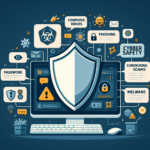
Are you wondering about the top 10 safety rules for the internet? In a world where technology plays a significant role in our daily lives, it is essential to know how to navigate the online world safely. This article will provide you with valuable insight into the safety precautions you should take while surfing the web, allowing you to enjoy all its benefits without compromising your personal information or security. So, let’s dive in and explore the 10 safety rules that can protect you in the vast online realm.

Use Strong and Unique Passwords
Create long and complex passwords
When creating passwords, it’s crucial to use ones that are both long and complex. A strong password is much harder for hackers to guess or crack. Aim for at least 12 characters, including a combination of uppercase and lowercase letters, numbers, and symbols.
Avoid using personal information as passwords
Don’t use personal information such as your name, birthdate, or address as passwords. These details are often easily accessible to hackers or can be guessed by individuals who know you personally. By using unique and unrelated passwords, you add an extra layer of security.
Use different passwords for each online account
Using the same password for multiple accounts is a risky practice. If one account gets compromised, all your other accounts are then vulnerable as well. It’s best to use different passwords for each online account to minimize the potential damage if one account gets hacked.
Keep Software and Devices Updated
Install software updates promptly
Software updates often include security patches and bug fixes that protect your devices from known vulnerabilities. Keeping your software up to date is essential for maintaining a secure digital environment. Make it a habit to install updates promptly, as delaying them can leave your devices susceptible to attacks.
Update antivirus and firewall software regularly
Antivirus and firewall software play a crucial role in protecting your devices from malware, viruses, and other online threats. To ensure maximum effectiveness, it’s important to keep these security tools updated regularly. Set your antivirus software to automatically update, or manually check for updates frequently.
Keep devices and operating systems up to date
In addition to software updates, it’s vital to keep the operating systems of your devices up to date. Operating system updates often include security enhancements, bug fixes, and improved functionalities. Regularly check for and install updates to ensure your devices are equipped with the latest security measures.

Beware of Phishing Attempts
Double-check email addresses before clicking on links
Phishing attempts often involve emails that appear to be from legitimate sources, prompting you to click on links that lead to malicious websites or downloads. Before clicking on any link, double-check the email address it came from. Be cautious of any email address that seems suspicious or is different from the usual address of the sender.
Be cautious of unsolicited emails and messages
Be wary of unsolicited emails and messages, especially those requesting personal information or directing you to click on suspicious links. Legitimate organizations rarely ask for sensitive information via email. If you receive an unexpected email or message, verify its authenticity through other means before taking any action.
Avoid providing personal or financial information via email
It’s important to refrain from sharing personal or financial information through email. Even if the email appears to be from a trusted source, it’s difficult to guarantee its security. Instead, opt for secure methods of sharing sensitive information, such as encrypted messaging apps or secure online portals.
Think Before Sharing Personal Information
Be mindful of what information you share online
When it comes to personal information, it’s crucial to be mindful of what you share online. Avoid sharing unnecessary details such as your home address, phone number, or full birthdate unless it is absolutely necessary. The less information available, the harder it is for cybercriminals to exploit it.
Avoid sharing sensitive personal details publicly
Publicly sharing sensitive personal details on social media platforms or online forums can have serious consequences. Avoid sharing information such as your social security number, financial account details, or passwords. Cybercriminals actively search for this type of information to engage in identity theft or financial fraud.
Review privacy settings on social media platforms
Take the time to regularly review and update your privacy settings on social media platforms. Ensure that only approved individuals can see your posts, personal information, and contact details. By adjusting your privacy settings appropriately, you can have more control over who can access your information.



Use Secure Wi-Fi Networks
Avoid using public Wi-Fi for sensitive activities
Public Wi-Fi networks, such as those found in cafes, hotels, or airports, are often unsecured. Hackers can easily intercept data transmitted over these networks, potentially compromising your sensitive information. Avoid conducting sensitive activities, such as online banking or shopping, while connected to public Wi-Fi.
Connect to encrypted Wi-Fi networks
When connecting to Wi-Fi networks, prioritize those that are encrypted. Encrypted networks use security protocols to protect data transmission, making it significantly harder for hackers to access your information. Look for Wi-Fi networks with the WPA2 or WPA3 security protocols and avoid networks that are marked as “open” or unencrypted.
Use a virtual private network (VPN) when accessing public Wi-Fi
For an extra layer of security, consider using a virtual private network (VPN) when connecting to public Wi-Fi networks. A VPN encrypts your internet connection, creating a secure tunnel for your data to travel through. It helps protect your online activities from prying eyes and adds an additional level of privacy and security.
Be Wary of Downloads and Attachments
Only download files from trusted sources
Downloading files from unfamiliar or untrustworthy sources can lead to malware infections or other security breaches. Stick to reputable websites and official app stores when downloading files or applications. Be cautious of websites that offer free downloads or pirated content, as they often harbor malicious files.
Scan downloaded files for viruses before opening
Take a proactive approach to security by scanning downloaded files for viruses or malware before opening them. Use reliable antivirus software to scan all downloads, ensuring that they are safe to open and won’t harm your device. Regularly update and run antivirus scans to keep your system protected.
Be cautious of email attachments, even from known senders
Email attachments, even from known senders, can be a source of malware or viruses. Cybercriminals may gain access to a person’s email account and send malicious attachments to their contacts. Always exercise caution and scan email attachments for malware before opening them, even if they appear to be sent by someone you know.

Practice Safe Browsing Habits
Avoid clicking on suspicious links or ads
When browsing the internet, it’s important to be cautious of suspicious links or ads. These can lead to malware infections or phishing websites. Hover over links before clicking on them to see the destination URL and verify if it looks legitimate. If something seems off, err on the side of caution and avoid clicking.
Verify website security before entering personal information
Before entering personal information on a website, verify its security. Look for “https://” at the beginning of the website’s URL, indicating that it has an SSL certificate and uses secure encryption protocols. Look out for a lock icon in the address bar as well. Avoid entering sensitive information on unsecured websites.
Use ad-blockers and pop-up blockers to reduce risks
Ad-blockers and pop-up blockers can help minimize the risks associated with unwanted advertisements and pop-up windows. These blockers prevent potentially malicious or deceptive ads from appearing, reducing the chances of accidentally clicking on harmful content. Consider installing reputable ad-blocker software as an additional layer of protection.
Teach Children Internet Safety
Supervise children’s online activities
Children are particularly vulnerable to online threats due to their limited experience and understanding of the risks. It’s crucial to supervise their online activities, especially when they are younger. Monitor the websites they visit, the apps they use, and their interactions with others online to ensure their safety.
Educate children about online privacy and stranger danger
Teaching children about online privacy and the potential danger of interacting with strangers is essential. Help them understand the importance of not sharing personal information with unknown individuals and the potential risks associated with doing so. Encourage open communication so children feel comfortable discussing any online encounters that make them uncomfortable.
Install parental control software and set restrictions
Parental control software can help create a safe online environment for children by blocking inappropriate content and limiting their access to certain websites or apps. It allows parents or guardians to set restrictions to ensure that children’s online activities are age-appropriate and aligned with their values.
Secure Your Social Media Accounts
Enable two-factor authentication for added security
Enabling two-factor authentication adds an extra layer of security to your social media accounts. This feature typically requires entering a verification code sent to your mobile device in addition to your password when logging in. It helps protect against unauthorized access even if someone manages to obtain your password.
Limit the amount of personal information shared on profiles
When it comes to social media profiles, it’s wise to limit the amount of personal information shared publicly. Avoid posting sensitive details such as your full birthdate, address, or phone number. Sharing too much personal information increases the risk of identity theft or being targeted for scams.
Regularly review and update privacy settings
Social media platforms frequently update their privacy settings, so it’s important to regularly review and update them to ensure your desired level of privacy. Check who can see your posts, personal information, and contact details. Adjust the settings according to your preferences and regularly review them as platform policies evolve.
Be Cautious of Online Purchases
Shop only on reputable websites
When making online purchases, it’s essential to shop only on reputable websites. Stick to well-known retailers or trusted online marketplaces. Look for customer reviews or ratings to get an idea of their trustworthiness. Avoid websites that seem unprofessional or lack secure payment options.
Check for secure payment options
Before making a purchase, ensure that the website offers secure payment options. Look for trusted payment gateways such as PayPal or secure credit card processing systems. Check for the padlock icon in the browser’s address bar, indicating that the website uses encryption to protect your payment information.
Read customer reviews and ratings before making a purchase
To ensure a positive online shopping experience, take the time to read customer reviews and ratings before making a purchase. Genuine reviews from previous customers can provide valuable insights into the product quality, seller’s reliability, and customer service. Consider reviews from multiple sources to form a well-informed opinion.














